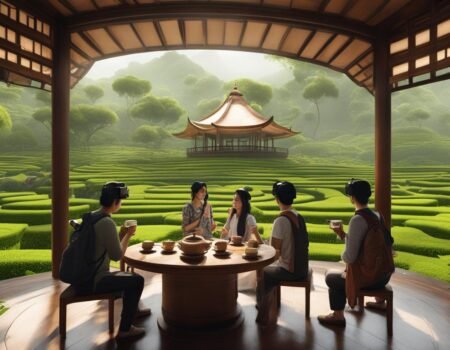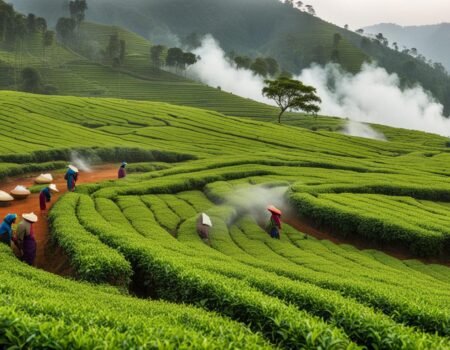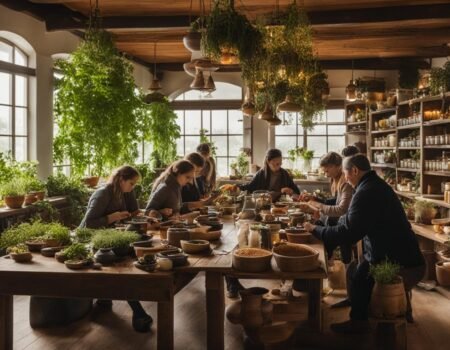
Tea Pairing Traditions Explored: China, India, and Sri Lanka
Tea pairing is an art that enhances dining experiences and elevates the enjoyment of tea. With its diverse flavors and cultural significance, tea has been paired with local cuisines in China, India, and Sri Lanka for centuries. In this article, we will delve into the traditional tea and food pairings of these three countries, exploring the unique combinations that create a harmonious fusion of tastes.
Each country has its own tea traditions and rituals, which add depth and meaning to tea consumption. From China’s renowned tea ceremonies to India’s love for chai, and Sri Lanka’s tea culture, we will uncover the cultural significance behind these tea pairings. Along the way, we will discover the ideal food pairings for each type of tea and explore the creativity and innovation in modern tea and food matches.
Key Takeaways:
- Tea pairing is an art that enhances dining experiences and elevates the enjoyment of tea.
- China, India, and Sri Lanka have rich tea pairing traditions that showcase diverse flavors and cultural significance.
- Understanding the different types of tea and their ideal food pairings can enhance the overall dining experience.
- Traditional tea ceremonies and rituals emphasize mindfulness and appreciation for tea.
- Modern tea consumption allows for creativity and innovation in pairing teas with food.
Tea Pairing Traditions in China
China has a rich tea culture that dates back thousands of years. Traditional Chinese tea ceremonies are steeped in artistry and precision, emphasizing the appreciation of flavor, aroma, and appearance. These ceremonies are a way to connect with nature and find harmony in the act of brewing and enjoying tea. They often involve specific rituals and utensils, such as the Gongfu tea set, which includes a teapot, cups, and a tea tray.
Tea houses are an integral part of Chinese tea culture and can be found in neighborhoods and business districts across the country. These establishments offer a wide variety of teas, allowing tea enthusiasts to explore different flavors and brewing techniques. Tea houses are also popular venues for social gatherings and business meetings, providing a relaxed and tranquil atmosphere.
One popular tea tradition in China is bubble tea, which originated in Taiwan but has gained widespread popularity in mainland China, especially among younger generations. Bubble tea is a delicious and refreshing beverage made with a base of tea, milk or fruit, and tapioca pearls. It can be customized with various flavors and toppings, making it a fun and vibrant choice for tea lovers.
| Chinese Tea Culture Highlights |
|---|
| Deep-rooted history and cultural significance |
| Emphasis on traditional tea ceremonies |
| Wide variety of teas and flavors |
| Popularity of bubble tea |
| Mindfulness and appreciation for tea |
Chinese tea culture is a testament to the country’s reverence for nature, art, and the pursuit of balance.
Tea Pairing Traditions in India
India has a rich tea culture that is deeply rooted in its culinary traditions and social fabric. One of the most iconic and beloved teas in India is chai. Chai is a spiced tea made with black tea, milk, and aromatic spices such as cardamom, ginger, and cinnamon. It is a staple beverage enjoyed by people of all ages throughout the country.
Traditional Indian tea-making involves a meticulous process that includes simmering the tea leaves, spices, and milk together to create a flavorful, fragrant cup of chai. The art of making chai has been passed down through generations, and each family may have its own unique recipe and combination of spices.
Chai is not just a beverage in India; it is a cultural phenomenon. It is often served as a welcoming drink to guests and is an integral part of social gatherings. Alongside chai, savory snacks like samosas or pakoras are commonly served, complementing the bold flavors of the tea.
“Chai is not just a beverage in India; it is a cultural phenomenon.”
Exploring Darjeeling Tea
Another notable tea from India is Darjeeling tea. Known as the “champagne of teas,” Darjeeling tea is grown in the picturesque hills of Darjeeling in the state of West Bengal. It has a distinct flavor profile with floral and fruity notes, making it a favorite among tea connoisseurs.
Darjeeling tea is often enjoyed without milk or sweeteners to fully appreciate its delicate flavors. It pairs well with light foods such as sandwiches, scones, and pastries, allowing its subtle nuances to shine through.
Artisanal Tea Culture
While chai remains a beloved favorite, India is also embracing the trend of artisanal and high-quality teas. Tea enthusiasts and entrepreneurs are exploring the vast tea estates and regions across India to discover unique and rare teas that offer a new experience.
This newfound interest in artisanal teas has led to the discovery of teas from different regions of India, each with its unique characteristics and flavors. From the aromatic Nilgiri teas of Tamil Nadu to the robust Assam teas in the northeastern part of the country, India offers a diverse range of teas for every tea lover to explore and enjoy.
| Tea Type | Flavor Profile | Food Pairings |
|---|---|---|
| Chai | Spiced, bold, aromatic | Samosas, pakoras, biscuits |
| Darjeeling | Floral, fruity, delicate | Scones, sandwiches, pastries |
| Assam | Robust, malty, strong | Rich breakfast foods, spicy dishes |
| Nilgiri | Fragrant, refreshing, citrusy | Light salads, smoked fish |
India’s tea culture is as diverse as its people and offers a wide array of flavors, aromas, and experiences. Whether you’re sipping on a steaming cup of chai or indulging in the delicate flavors of Darjeeling tea, the rich tea traditions of India are sure to leave a lasting impression.
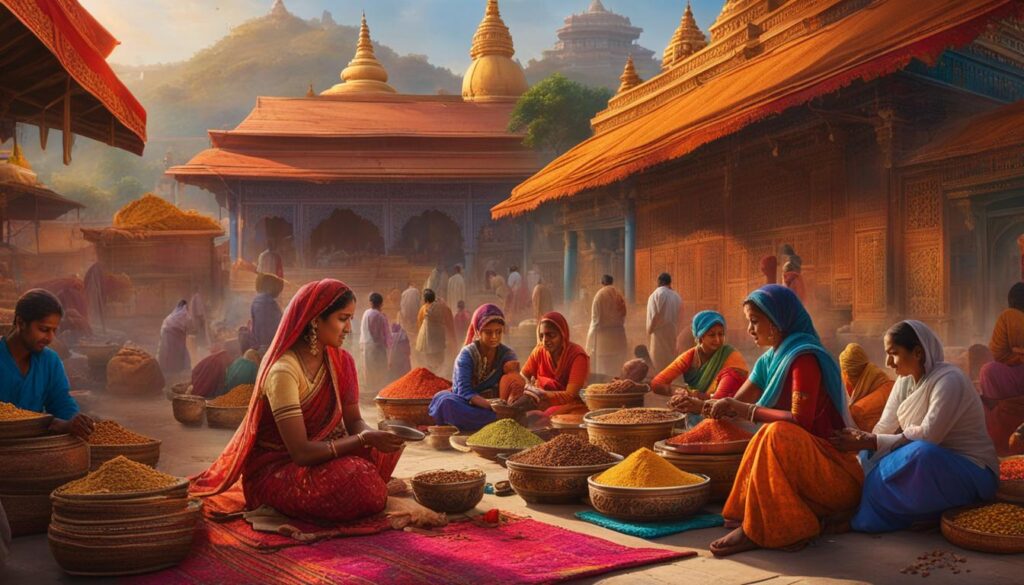
Tea Pairing Traditions in Sri Lanka
Sri Lanka, formerly known as Ceylon, has a rich tea culture that is deeply ingrained in its history and culinary traditions. The island nation is renowned for its tea production, particularly the famous Ceylon tea. This type of fruity green tea is a popular choice for tea pairings in Sri Lanka and beyond, thanks to its unique flavor profile.
One notable aspect of Sri Lankan tea culture is the blending of tea with fresh fruits to enhance its taste. This practice adds a delightful twist to the tea-drinking experience and creates a harmonious fusion of flavors. Sri Lankan teas, especially those with fruity notes, are often consumed as standalone beverages due to their delicious flavors.
Tea is a common drink in Sri Lankan restaurants and cafes, where it complements a variety of dishes. Sri Lankan tea culture values the harmony of tea and cuisine, aiming to create a balanced and enjoyable dining experience. Whether it’s a refreshing cup of Ceylon tea with spicy curry or a soothing blend with sweet treats, tea plays a vital role in the Sri Lankan culinary landscape and is cherished by locals and visitors alike.
| Tea Pairing Traditions in Sri Lanka | Highlights |
|---|---|
| Ceylon tea | A type of fruity green tea that is popular for tea pairings |
| Blending with fresh fruits | Fruits are added to enhance the flavor of the tea |
| Common drink in restaurants and cafes | Tea complements a variety of Sri Lankan dishes |
| Tea and cuisine harmony | Sri Lankan tea culture aims to create a balanced dining experience |
| Fruity tea varieties | Enjoyed as standalone beverages due to their delicious flavors |
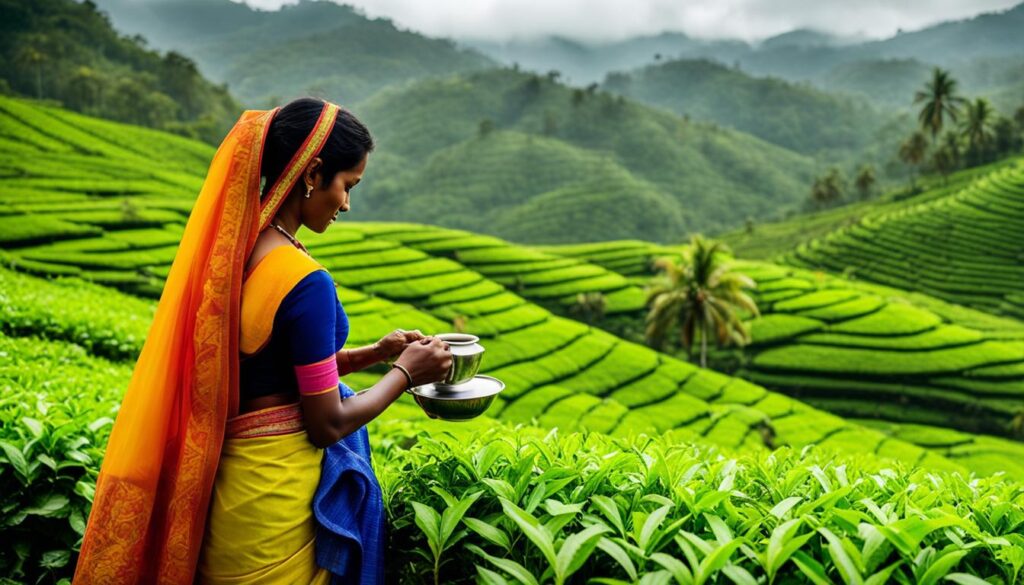
Tea is not merely a drink in Sri Lanka; it’s woven into the fabric of our culture and heritage. The art of tea-making and tea pairing is a reflection of our love for flavor and the joy of sharing a cup of tea with loved ones. We strive to create a harmonious blend of tea and cuisine, allowing our taste buds to embark on a delightful culinary journey.
Exploring the Delights of Ceylon Tea
When it comes to enjoying Ceylon tea, there are endless possibilities. The fruity notes of this green tea make it a versatile choice for pairing with a variety of dishes. The delicate flavors of Ceylon tea can complement both sweet and savory flavors, making it a perfect companion for a range of cuisines.
For a refreshing twist, try pairing Ceylon tea with tropical fruits like mangoes or pineapples. The natural sweetness of the fruits enhances the tea’s flavor and creates a vibrant taste experience. If you prefer something savory, Ceylon tea pairs well with spicy Sri Lankan curries or seafood dishes, balancing out the heat with its smooth and fruity undertones.
Whether you’re a tea enthusiast or an adventurous foodie, the tea pairing traditions in Sri Lanka offer a world of gastronomic delights. Immerse yourself in the rich tea culture of Sri Lanka and embark on a journey of flavors that will leave you craving for more.
Conclusion
In conclusion, tea pairing traditions in China, India, and Sri Lanka offer a fascinating exploration of flavors and cultural significance. By understanding the different types of tea and their ideal food pairings, we can elevate our dining experiences and create culinary harmony.
Traditional tea ceremonies and rituals in these countries emphasize the mindfulness and appreciation of tea. They remind us that tea is not just a beverage, but a sensory experience that can enhance our connection to food and culture.
However, the modern tea scene also showcases the creativity and innovation in pairing teas with food. By exploring tea pairing traditions and experimenting with innovative matches, we can unlock a world of delightful culinary possibilities.
So let’s embrace the creativity in tea pairings and embark on a journey of exploring tea with food. Together, we can discover the unique and innovative tea and food matches that will elevate our taste buds and bring joy to our dining experiences. Cheers to the wonderful world of tea!
FAQ
What is tea pairing?
Tea pairing is a skill that can enhance dining experiences and elevate the enjoyment of tea. It involves matching different types of tea with complementary foods to create harmonious flavor combinations.
How many varieties of tea are there?
There are many varieties of tea, but they all come from the same plant and differ in flavor and aroma based on factors like growth location and preparation.
Which tea is versatile and great for tea pairings?
Sencha tea from China and Japan is versatile and can be brewed in different ways to produce varying flavors and strengths, making it a great option for tea pairings.
Are there specific food pairings for different green tea varieties?
Yes, other green tea varieties, such as herbal/earthy and fruity, have specific food pairings that complement their flavors.
What kind of food is often paired with Pu-erh tea?
Pu-erh tea from China is known for its earthy flavor and is often paired with stir-fry or chicken dishes.
What foods can be paired with Oolong tea?
Oolong tea, with its range of flavors from dark to light, can be paired with a variety of foods like light meats, desserts, and pancakes.
What kind of dishes go well with black tea?
Black tea, with its smoky and fruity variants, is commonly enjoyed with dark meats and sweet desserts.
What foods are commonly paired with white tea?
White tea has a delicate flavor and pairs well with salads or fruits like melons and peaches.
What is the cultural significance of tea in China?
Tea has a deep-rooted history and cultural significance in China, with various tea traditions and ceremonies observed.
What is the importance of traditional Chinese tea ceremonies?
Traditional Chinese tea ceremonies emphasize the art of tea-making and the appreciation of flavor, aroma, and appearance.
Are tea houses popular in China?
Yes, tea houses are popular in Chinese neighborhoods and business districts, offering a wide variety of teas and tea-related snacks.
Where did bubble tea originate?
Bubble tea, a Taiwanese invention, has become popular in China, particularly among younger generations.
What is the significance of tea tumbler cups in China?
Tea tumbler cups are common in China, allowing people to carry their tea conveniently and maintain its temperature.
Why is tea important to Chinese people, even when traveling?
Chinese people believe that tea is essential for maintaining good health and balance, even when traveling.
What are the values of Chinese tea culture?
Chinese tea culture values mindfulness, simplicity, and respect for tea and its guests.
What is the popular type of tea in India?
Chai, a spiced tea made with black tea, milk, and aromatic spices, is a popular type of tea in India.
Are there traditional Indian tea ceremonies?
Yes, traditional Indian tea ceremonies involve the use of special pots and a mix of spices for making chai.
What kind of foods are enjoyed with chai?
Chai is often served as a welcoming drink and is enjoyed with savory snacks like samosas or pakoras.
Has iced chai gained popularity in India?
Yes, in modern India, iced chai has gained popularity during hot summer months.
What is Darjeeling tea known for?
Darjeeling tea is known for its floral and fruity notes and is often enjoyed without milk or sweeteners.
What is the significance of tea in Sri Lanka?
Sri Lanka, formerly known as Ceylon, is renowned for its tea production and culture.
What is Ceylon tea?
Ceylon tea is a type of fruity green tea and is a popular choice for tea pairings in Sri Lanka and beyond.
Are there tea houses in Sri Lanka?
Yes, tea is a common drink in Sri Lankan restaurants and cafes, complementing a variety of dishes.
What are Sri Lankan tea culture values?
Sri Lankan tea culture values the harmony of tea and cuisine, aiming to create a balanced and enjoyable dining experience.
Can Sri Lankan teas be enjoyed on their own?
Yes, Sri Lankan teas, especially the fruity varieties, are often consumed as a standalone beverage due to their delicious flavors.
What can enhance the overall dining experience with tea?
Understanding the different types of tea, their flavors, and their ideal food pairings can enhance the overall dining experience.
What do traditional tea ceremonies emphasize?
Traditional tea ceremonies and rituals add depth and meaning to tea consumption, emphasizing mindfulness and appreciation.
What does modern tea consumption showcase?
Modern tea consumption showcases the creativity and innovation in pairing teas with food in unique and enjoyable ways.
How does tea elevate the flavors of different cuisines?
Tea has the power to elevate the flavors of different cuisines, creating a harmonious fusion of tastes.
What can experimenting with tea and food matches lead to?
Exploring tea pairing traditions and experimenting with innovative tea and food matches can lead to delightful culinary experiences.



